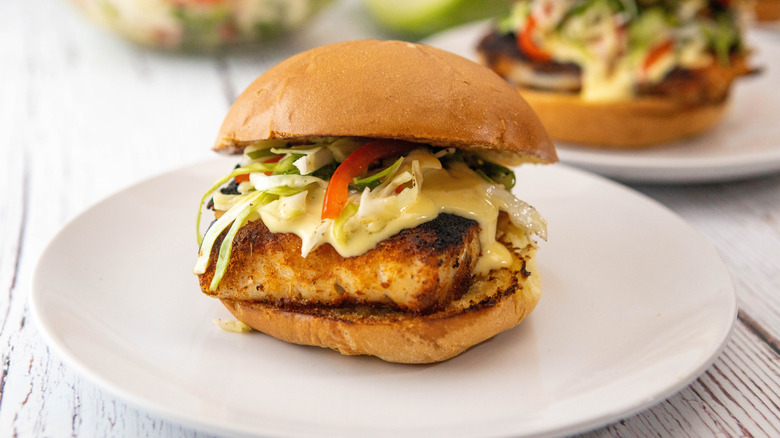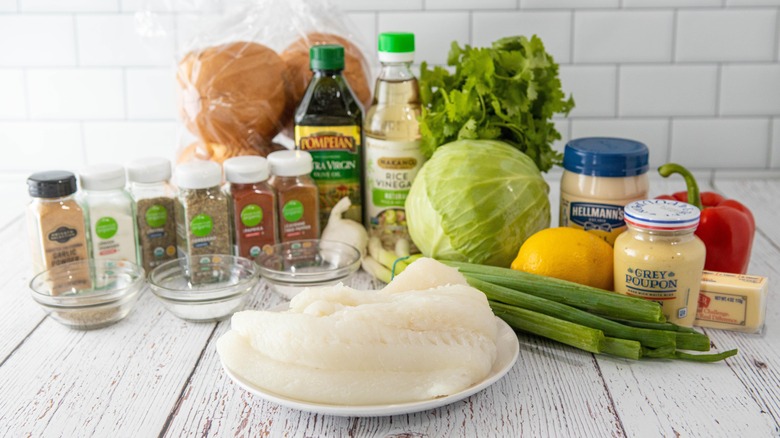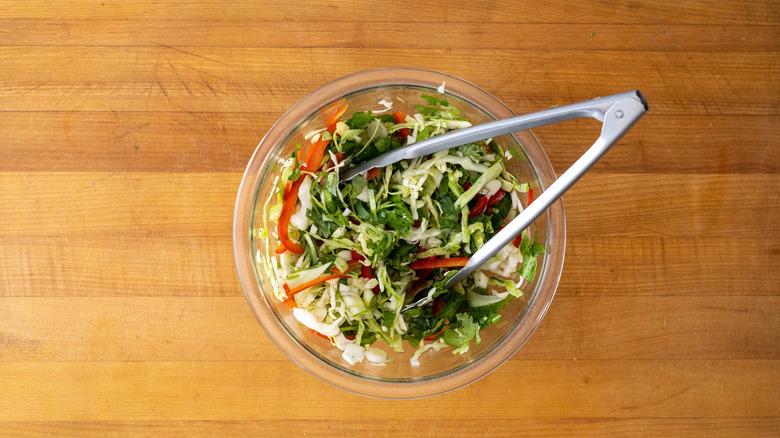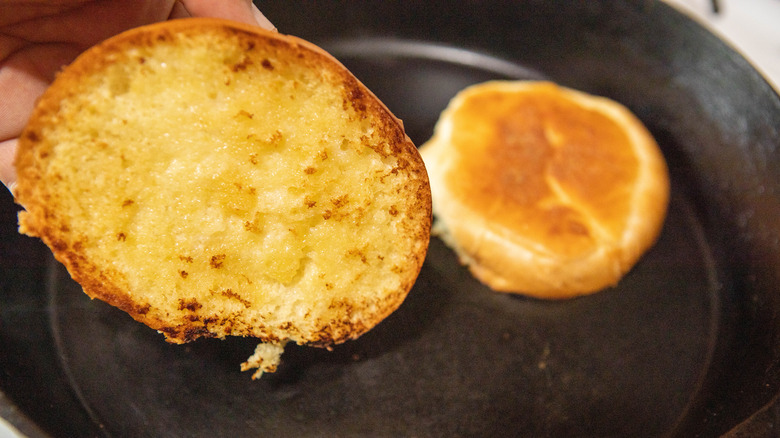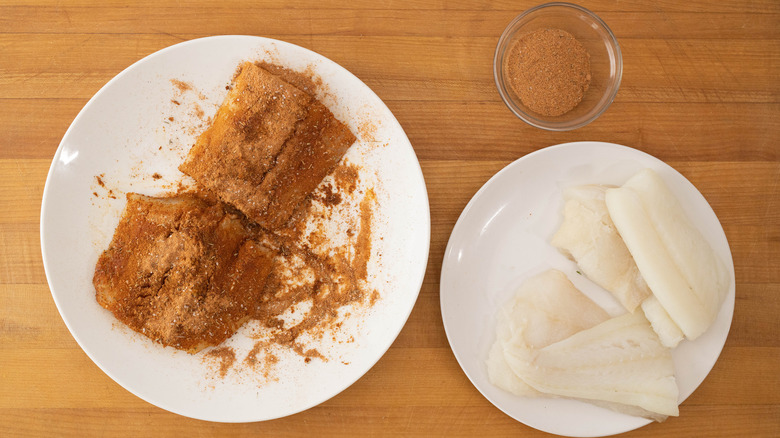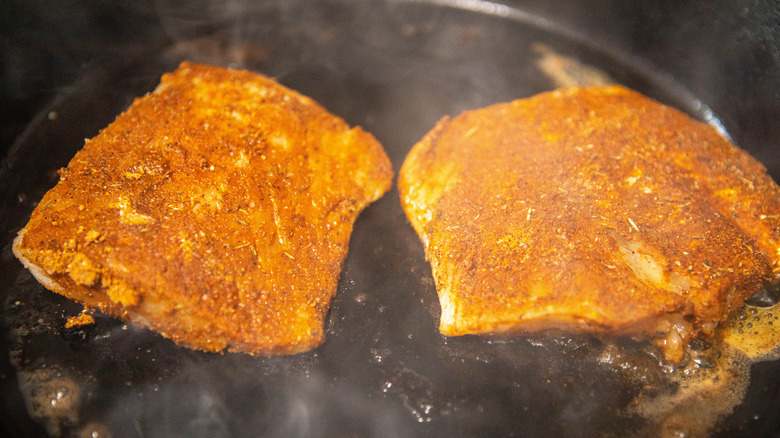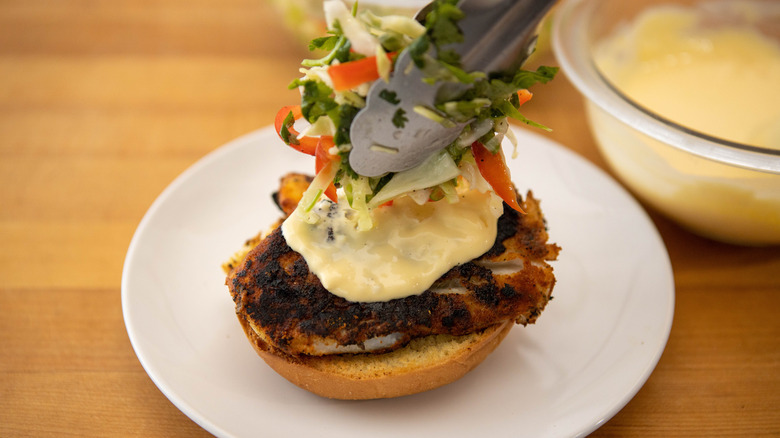Classic Blackened Fish Sandwich Recipe
Dreaming of lazy days by the shore? If you can't make the trip right now, then bring the beach to you with a blackened fish sandwich. This take on the New Orleans classic was created by chef Keith Kamikawa, a Wisconsin native with a passion for all things flavor. The star of the show is the heavily spiced cod or catfish, shining here with a crispy outer layer and a buttery, flaky middle. The complementary features that take this sandwich to the next level are the fresh, crunchy coleslaw, creamy garlic aioli, and toasted buns, all of which stand up well to the complex flavors of the fish itself.
"Blackened fish is one of the first non-Wisconsin ways of cooking fish I ever made, and one of the first styles of cooking I learned when I started as a professional cook way back when I was 16," says Kamikawa. "It holds a special place in my heart. Nothing beats the flavor profile of the peppery dark, spicy, blackened crust on a great piece of fish."
So, if you're ready to recreate Kamikawa's summer dish, let's waste no more time salivating and get to the actual cooking.
Gather your ingredients
Before you can begin constructing the sandwich of your dreams, make sure you have the right ingredients. Kamikawa's recipe calls for 4 hard rolls and 4 pieces of catfish or cod, about 6 to 8 ounces each. For the spice rub, you will need 4 tablespoons of paprika, 2 tablespoons of cayenne pepper, 2 teaspoons of black pepper, 1 teaspoon of dried thyme, 4 teaspoons of onion powder, 2 teaspoons of garlic powder, 1 teaspoon of dried oregano, and ½ tablespoon of kosher salt. Ideally, you'll use a cast iron pan for toasting the buns and blackening the fish.
You will also need to have the ingredients for a tangy coleslaw and garlic aioli on hand. For the coleslaw, Kamikawa recommends using ¼ head of cabbage, ½ ounce of cilantro, ½ of a julienned red pepper, and 2 sliced green onions. The veggies will then be tossed in a vinaigrette made with 2 tablespoons of white rice vinegar, 2 teaspoons of granulated sugar, ¼ teaspoon of black pepper, 1 tablespoon of extra virgin olive oil, and 1 teaspoon of kosher salt.
If you're wondering why this coleslaw recipe doesn't have any mayonnaise or milk, remember that you'll have a creamy garlic aioli to round out your flavors. Kamikawa's aioli calls for ½ cup of mayonnaise, 2 teaspoons of lemon juice, 2 minced cloves of garlic, 1 teaspoon of Dijon mustard, and ⅛ teaspoon of kosher salt. Just be sure to refrigerate both the coleslaw and the aioli until you're ready to build your sandwiches.
Make sweet, tangy coleslaw and creamy garlic aioli
The order of your recipe is important, which is why Kamikawa recommends that you make your coleslaw and garlic aioli first. To create the coleslaw, first whisk together the rice wine vinegar, 1 teaspoon kosher salt, granulated sugar, ¼ teaspoon black pepper, and extra-virgin olive oil in a medium-sized bowl. Then slice the cabbage, red pepper, and green onions into very thin, slightly long pieces and add those to the bowl, making sure the veggies are well-coated in the dressing.
Need a pro tip for the perfect slices? "Take your time and make sure your knife is sharp," Kamikawa says. "Slice the cabbage as thin as you can get it, but don't stress if it's not all crazy thin or consistent." Kamikawa suggests making the coleslaw a few hours ahead of schedule if you think you'll be pressed for time later. While the mix is resting in the fridge, the vinaigrette will have the time to truly penetrate the vegetables and create a beautifully blended flavor.
Creating the garlic aioli is even more simple. To make it, simply whip together the mayonnaise, lemon juice, minced garlic, Dijon mustard, and salt. Just like the coleslaw, refrigerating the aioli until use will help meld and enhance the flavors.
Toasting buttered buns changes the game
While it seems unnecessary to add butter to a hard roll or brioche bun, it's actually an important step that will take this sandwich to the next level. Buttering allows for the buns to toast more quickly in a cast iron skillet and gives them delightfully crisp edges. Plus, toasting the bread prevents it from soaking up all the juices from the aioli, coleslaw, and fish. It's the perfect little trick to stop your hard-earned sandwiches from becoming a soggy mess.
Instead of sticking your buns in a toaster, heat up your cast iron skillet on medium heat. Butter both sides of the top and bottom bun, which will create both crispy edges on the inside and a beautiful shine on the outside. Kamikawa notes that a mere 30 seconds on each side should be the perfect amount of time to toast the buns, though you can keep them on the heat for more or less time depending on your preference.
Picking the right fish and seasoning it to perfection
Now that you've taken care of the coleslaw and aioli, you're finally ready to get to the meat of the sandwich: the fish. Kamikawa recommends using cod or catfish for this recipe, as both hold up well inside a bun and aren't prone to falling apart.
"Cod works great for its availability and is a nice, friendly fish," he says. "Catfish is more traditional and is firmer. You can't go wrong with catfish." If you want to try something a little more on the high end, Kamikawa suggests more expensive swordfish. "Swordfish, due to its steak-like texture, is a fantastic option," he notes. "Any fish that tends to be on the firmer side is great."
With the fish of your choice, first whisk together your spices, which are paprika, cayenne pepper, dried thyme, onion powder, garlic pepper, black pepper, and salt. Then, coat each piece of fish thoroughly in this spice rub. You may do so by pouring the dried spices onto the fish and then rubbing them evenly into every side with your hands. Or, you may use a utensil like a butter knife or spoon to evenly spread the spice rub onto every side of the filet.
Cook the fish
Not to put too much pressure on you, but the way you cook your fish will definitely determine the quality of your sandwich. Kamikawa recommends a cast iron skillet for the job because of its versatility and ability to meld the flavors like no other pan. "I'll always go with a well seasoned cast iron pan. If it's a vintage Griswold or Wagner, even better," he explains. If you don't have a cast iron pan, Kamikawa suggests using a heavy, thick gauged pan instead. "The thick gauged pan offers even heat and can handle the hot temperatures no problem," he says. You'll be heating the pans on high heat, so be sure to use one that can maintain that heat and definitely avoid nonstick pans.
When your pan has heated up, add one tablespoon of unsalted butter to the pan. When the butter begins to smoke, add two fish pieces to the pan and sear it for about two to three minutes on each side. You should be able to easily pull the fish away from the pan when flipping, due in part to the heavy coating of seasoning. Repeat for the final two fish pieces. According to the U.S. Food Safety website, the fish should reach an internal temperature of 145° F, and the flesh should be opaque and flake easily with a fork.
Putting together the ideal blackened fish sandwich
With your fish fresh out of the pan and your coleslaw and aioli resting in the fridge, you are finally ready to assemble the ultimate summer sandwich. Each toasted bun should receive one portion of the blackened fish, about one tablespoon of garlic aioli, and about ¼ cup of coleslaw.
Wondering what sides will stand up to the blackened fish sandwich of your dreams? "Sweet potato fries or chips are awesome with blackened fish sandwiches," Kamikawa notes. The chef's other tasty recommendations include Southern classics like hush puppies or fried okra. Ultimately, the side is up to you.
Homemade blackened fish sandwich recipe
Dreaming of some lazy days by the shore? If you can't make the trip right now, then bring the beach to you with this classic blackened fish sandwich recipe.
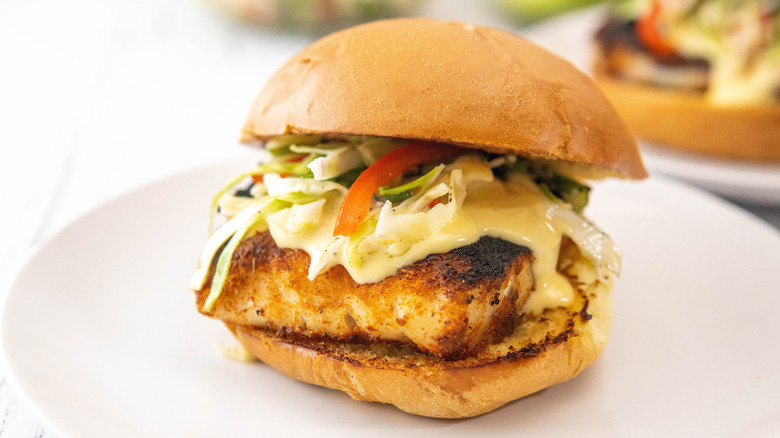
Ingredients
- 2 tablespoons rice wine vinegar
- 1 ⅝ teaspoons kosher salt
- 2 teaspoons granulated sugar
- 2 ¼ teaspoons black pepper
- 1 tablespoon extra-virgin olive oil
- ¼ head cabbage
- ½ ounce cilantro
- ½ red pepper
- 2 green onions
- 4 tablespoons paprika
- 2 tablespoons cayenne pepper
- 2 teaspoons black pepper
- 1 teaspoon dried thyme
- 4 teaspoons onion powder
- 2 teaspoons garlic powder
- 1 teaspoon dried oregano
- ½ cup mayonnaise
- 2 teaspoons lemon juice
- 2 cloves garlic minced
- 1 teaspoon Dijon mustard
- 4 buns
- 4 6-8 ounce pieces of cod or catfish
- 3 teaspoons butter
Directions
- To make the coleslaw, whisk together rice wine vinegar, 1 teaspoon kosher salt, granulated sugar, ¼ teaspoon black pepper, and extra-virgin olive oil in a medium-sized bowl.
- Thinly slice cabbage and green onions. Chop the cilantro and julienne the red pepper.
- Add cabbage, cilantro, red pepper, sliced green onions to the bowl and toss with the vinaigrette. Refrigerate until use.
- For the lemon garlic aioli, mix mayonnaise, lemon juice, minced garlic, Dijon mustard, and ⅛ teaspoon kosher salt. Refrigerate until use.
- To make the blackening seasoning, combine 4 tablespoons paprika, 2 tablespoons cayenne pepper, 2 teaspoons black pepper, 1 teaspoon dried thyme, 4 teaspoons onion powder, 2 teaspoons garlic powder, 1 teaspoon dried oregano, and ½ tablespoon kosher salt.
- Toast the buns in a cast iron pan or thick gauged pan on medium heat. Butter each side of the buns with ¼ tablespoon of butter. Toast the buns in a cast iron pan for about 30 seconds and set aside.
- Coat each piece of fish thoroughly with blackening seasoning.
- Heat a cast iron or thick gauged pan on high heat. Blacken the fish in two batches. When the cast iron pan is hot, add 1 tablespoon of unsalted butter. When the butter is smoking, carefully add two portions of fish to the pan.
- Sear for 2 to 3 minutes on the first side, then carefully flip the blackened fish. The fish should easily pull away from the pan. Sear on the opposite side for 2 to 3 minutes until done. Repeat for the second batch.
- Place one portion of fish on the bottom of each toasted bun. Top the blackened fish with about 1 tablespoon lemon garlic aioli and about ¼ cup of slaw. Place the top of each bun on the slaw and serve.
Nutrition
| Calories per Serving | 620 |
| Total Fat | 33.1 g |
| Saturated Fat | 6.6 g |
| Trans Fat | 0.1 g |
| Cholesterol | 104.2 mg |
| Total Carbohydrates | 39.4 g |
| Dietary Fiber | 7.6 g |
| Total Sugars | 8.8 g |
| Sodium | 915.2 mg |
| Protein | 42.9 g |
